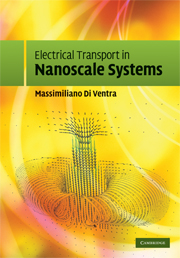Book contents
- Frontmatter
- Contents
- Preface
- 1 A primer on electron transport
- 2 Drude model, Kubo formalism and Boltzmann equation
- 3 Landauer approach
- 4 Non-equilibrium Green's function formalism
- 5 Noise
- 6 Electron-ion interaction
- 7 The micro-canonical picture of transport
- 8 Hydrodynamics of the electron liquid
- Appendices
- References
- Index
8 - Hydrodynamics of the electron liquid
Published online by Cambridge University Press: 06 July 2010
- Frontmatter
- Contents
- Preface
- 1 A primer on electron transport
- 2 Drude model, Kubo formalism and Boltzmann equation
- 3 Landauer approach
- 4 Non-equilibrium Green's function formalism
- 5 Noise
- 6 Electron-ion interaction
- 7 The micro-canonical picture of transport
- 8 Hydrodynamics of the electron liquid
- Appendices
- References
- Index
Summary
In the preceding Chapter I have discussed an alternative picture of transport, which I called micro-canonical. From this picture we have learned that electrons flow from one electrode to the other across a nanojunction like a liquid would do in confined geometries. This was illustrated in Fig. 7.3.
The junction is an unavoidable obstacle for the electrons, which need to change their momenta while crossing it. This forces the system to reach local equilibrium fast, greatly helping the effect of other inelastic processes whose role is also to force the system towards local equilibrium.
To the above properties we need to add the known fact that, due to Coulomb interactions, the electron liquid is also viscous, namely electronelectron interactions create an internal friction for an electron to propagate through the electron liquid, much like the friction experienced by an object moving across a viscous liquid or gas.
To be more specific, the shear viscosity of the electron liquid at the density of a typical metal, such as gold, is about 10-7 Pa s (from Eq. F.8 with rs = 3a0). For comparison the viscosity of water at room temperature is about 10-3 Pa s.
The viscosity of the electron liquid is thus very small but not zero. In fact, the smaller the viscosity, the less stable the flow with respect to perturbations, especially those provided by obstacles or constrictions along the path.
- Type
- Chapter
- Information
- Electrical Transport in Nanoscale Systems , pp. 376 - 414Publisher: Cambridge University PressPrint publication year: 2008



